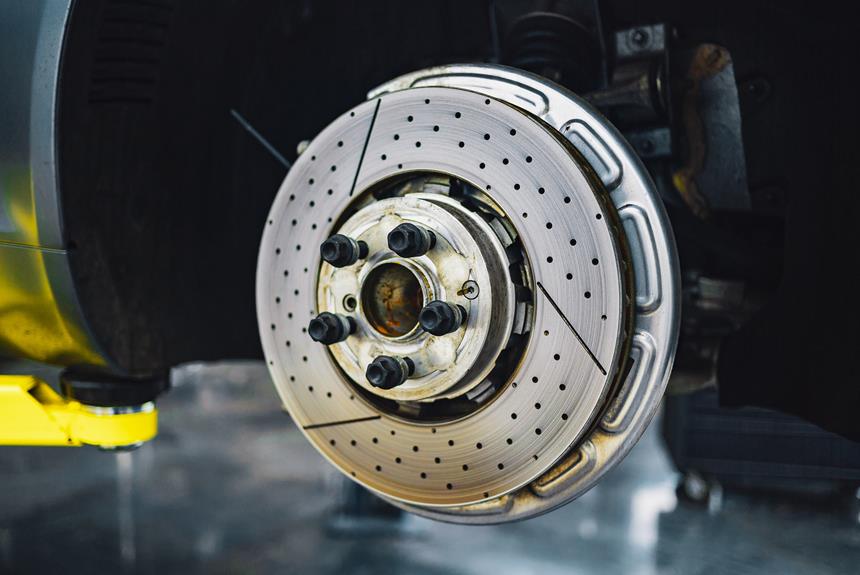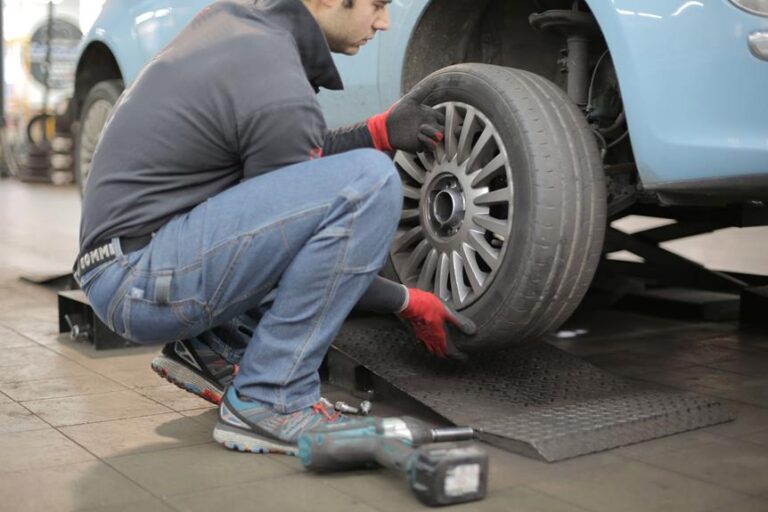Tire Rotation: Extend the Lifespan of Your Tires
Tire rotation is a simple yet powerful technique that symbolizes the freedom to extend the lifespan of your tires. As an informed vehicle owner, understanding the importance of tire rotation and its benefits is crucial.
In this article, we will delve into the significance of regular tire rotation, the signs that indicate the need for rotation, and the different methods available. Whether you choose to DIY or seek professional services, mastering the art of tire rotation will help you maximize tire longevity and ensure a smooth, safe ride.
Key Takeaways
- Tire rotation helps distribute wear evenly across all tires, maximizing their lifespan and saving money in the long run.
- Regular tire rotation maintains optimal tire performance and improves traction and handling, enhancing safety on the road.
- Following the recommended tire rotation frequency and pattern based on the type of vehicle and driving conditions is crucial for balanced wear and optimal performance.
- DIY tire rotation can be done with the necessary tools, but professional services provide expert assessment, access to specialized equipment, and compliance with warranty requirements.
The Importance of Tire Rotation
The significance of regular tire rotation cannot be overstated as it plays a crucial role in maintaining optimal tire performance and prolonging their durability. Tire rotation benefits both the safety and lifespan of your tires.
The primary benefit of tire rotation is the even distribution of wear. Tires tend to wear unevenly due to differences in weight distribution and driving conditions. By rotating the tires regularly, you can ensure that the wear is distributed evenly across all tires, maximizing their lifespan and saving you money in the long run.
There are different methods of tire rotation depending on the type of vehicle and tire setup. The most common method is the cross pattern rotation, where the front tires are moved to the opposite rear position, and the rear tires are moved to the opposite front position. This helps to ensure that each tire experiences different driving forces and wear patterns, resulting in more balanced wear.
Another method is the front-to-rear rotation, where the front tires are moved straight to the rear, and the rear tires are moved straight to the front. This method is often used for vehicles with directional tires or different sizes on the front and rear axles.
Overall, regular tire rotation is essential for maintaining optimal tire performance and extending their lifespan. By following the appropriate tire rotation methods, you can ensure that your tires wear evenly, enhancing safety and saving money in the long term.
How Often Should You Rotate Your Tires
Regular tire rotation is essential for maintaining optimal tire performance and extending their lifespan. The frequency of tire rotation depends on several factors, including the type of vehicle, driving conditions, and tire wear patterns.
In general, it is recommended to rotate your tires every 5,000 to 7,500 miles or as specified in your vehicle's owner's manual. Regular rotation helps promote even tread wear, improves traction, and ensures a smoother, safer ride.
Optimal Tire Rotation Frequency
One should consider their driving habits and manufacturer recommendations when determining the optimal frequency for tire rotation.
Tire rotation is an essential maintenance procedure that helps to ensure even wear on all four tires, extending their lifespan and maximizing performance.
The optimal tire rotation interval can vary depending on several factors, such as the type of vehicle, driving conditions, and tire wear patterns. Generally, it is recommended to rotate tires every 5,000 to 8,000 miles or every six months, whichever comes first.
However, it is crucial to refer to the specific recommendations provided by the tire manufacturer and your vehicle's manual. Different tire rotation patterns, such as front-to-back, side-to-side, or the cross pattern, can also be employed to achieve more balanced wear.
Regular tire rotation not only promotes safety but also saves money by avoiding premature tire replacement.
Benefits of Regular Rotation
By regularly rotating your tires, you can experience improved traction and handling, ultimately enhancing the overall safety of your vehicle. Tire rotation involves moving each tire from one position to another on your vehicle at regular intervals. This practice ensures even wear on all tires, which leads to increased tire traction and improved vehicle stability.
When tires wear unevenly, it can affect the way your vehicle handles and performs on the road. Unevenly worn tires may reduce traction, especially in wet or slippery conditions, increasing the risk of accidents. Regular tire rotation helps distribute the wear evenly, allowing each tire to maintain optimal grip on the road.
This not only enhances traction but also improves vehicle stability, providing a safer driving experience for you and your passengers.
Signs That Your Tires Need to Be Rotated
Regular tire rotation is essential to maintaining the performance and longevity of your tires.
Signs that your tires need to be rotated include uneven tread wear, decreased fuel efficiency, and poor vehicle handling.
Uneven Tread Wear
Proper tire rotation can help prevent uneven tread wear, ensuring optimal performance and longevity of your tires. Uneven wear occurs when tires are not rotated regularly, leading to a variety of issues such as decreased traction, reduced fuel efficiency, and potential safety hazards. To avoid these problems, it is important to follow a regular tire rotation schedule.
Here are four key benefits of tire rotation:
- Balanced wear: Rotating tires allows for even distribution of wear across all tires, preventing one tire from wearing out faster than the others.
- Improved traction: Even tread wear ensures better grip on the road, especially in wet or slippery conditions, enhancing overall safety.
- Extended lifespan: Regular rotation helps to equalize tire wear, maximizing the life expectancy of your tires and saving you money in the long run.
- Enhanced performance: Properly rotated tires maintain optimal performance, providing a smoother and more comfortable ride.
Decreased Fuel Efficiency
One sign that your tires may need to be rotated is decreased fuel efficiency, as uneven wear can lead to increased resistance and higher fuel consumption. Regular tire rotation is an important maintenance task that can help improve mileage and extend the lifespan of your tires. When tires are not rotated, they tend to wear unevenly, with the front tires wearing more on the outside edges and the rear tires wearing more on the inside edges. This uneven wear can result in decreased fuel efficiency and also have an impact on tire traction, affecting the overall performance and safety of your vehicle. By rotating your tires regularly, you can ensure that they wear more evenly and maintain optimal traction, leading to improved fuel efficiency and a smoother, safer ride.
| Tire Position | Recommended Rotation Pattern |
|---|---|
| Front Left | Move to Rear Right |
| Front Right | Move to Rear Left |
| Rear Left | Move to Front Right |
| Rear Right | Move to Front Left |
| Spare Tire | Not applicable |
Poor Vehicle Handling
Inadequate tire rotation can contribute to poor vehicle handling, affecting the stability and control of the vehicle during maneuvers. To ensure optimal tire performance, it is crucial to follow proper tire maintenance tips. Here are four essential factors to consider:
- Regular Rotation: Rotating your tires regularly promotes even wear, extending their lifespan and improving handling. This involves moving the front tires to the back and vice versa, as well as switching sides.
- Proper Inflation: Improper tire inflation can lead to decreased handling capabilities and increased risk of accidents. It is important to check tire pressure regularly and maintain it at the recommended levels.
- Alignment and Balancing: Proper alignment and balancing of tires are crucial for maintaining vehicle stability and control. Misaligned tires can cause uneven wear and affect handling.
- Tread Depth: Monitor the tread depth regularly, as worn-out tires can compromise handling and safety. Replace tires when the tread depth reaches the recommended minimum.
The Benefits of Regular Tire Rotation
Regularly rotating your tires can improve fuel efficiency and enhance overall vehicle performance. Tire rotation involves moving the front tires to the back and vice versa, as well as switching sides. This process helps distribute the wear and tear on the tires more evenly, prolonging their life and saving you money in the long run.
One of the key benefits of regular tire rotation is prolonging tire life. By evenly distributing the wear patterns, it prevents certain areas of the tire from wearing out faster than others. This means that you can get more mileage out of each tire, reducing the frequency of tire replacements and saving you money.
Additionally, rotating your tires can improve traction. As tires wear down, they lose their grip on the road, which can be dangerous, especially in wet or snowy conditions. By regularly rotating your tires, you can ensure that all your tires have the same level of tread depth, resulting in better traction and improved handling.
Tire Rotation Methods: Front to Back Vs. Cross Pattern
Tire rotation methods can vary, but choosing between front to back and cross pattern rotation is crucial for maintaining tire longevity and performance. Here are four key points to consider when deciding on the best tire rotation method for your vehicle:
- Front Wheel Drive: In vehicles with front wheel drive, the front tires typically wear out faster than the rear tires due to the weight distribution and power delivery. Rotating the tires from front to back helps to even out the wear and extend the lifespan of the tires.
- Rear Wheel Drive: In vehicles with rear wheel drive, the rear tires tend to wear out faster due to the weight distribution and power delivery. Rotating the tires from back to front helps to distribute the wear and maximize the lifespan of the tires.
- Cross Pattern Rotation: This method involves moving the front tires to the opposite rear position and the rear tires to the opposite front position. Cross pattern rotation ensures that all tires experience different positions on the vehicle, which promotes even wear and extends tire life.
- Manufacturer Recommendations: It is important to refer to the vehicle manufacturer's guidelines for tire rotation. They may provide specific recommendations based on the vehicle's design and drivetrain configuration. Following these recommendations will help maintain optimal tire performance and ensure the longevity of your tires.
By understanding the tire rotation methods and considering factors such as front wheel drive or rear wheel drive, you can make an informed decision on the most suitable rotation pattern for your vehicle.
Regular tire rotation is essential for maintaining balanced tread wear, improving traction, and maximizing the lifespan of your tires.
DIY Tire Rotation: Step-by-Step Guide
When performing a DIY tire rotation, it is important to follow a step-by-step guide to ensure proper tire placement and maximize the lifespan of your tires. To begin, gather the necessary tools: a jack, jack stands, a lug wrench, and a tire pressure gauge.
Start by loosening the lug nuts on each tire before lifting the vehicle using the jack. Once the vehicle is elevated, place the jack stands securely under the vehicle for added safety.
Next, remove each tire and inspect them for any signs of wear or damage.
The step-by-step process for tire rotation depends on the type of vehicle you have. For front-wheel drive vehicles, the front tires should be moved to the back in a straight line, while the rear tires should be crossed to the front. For rear-wheel drive vehicles, the opposite should be done. For all-wheel drive vehicles, a side-to-side rotation is recommended.
Regular tire rotation offers several benefits. Firstly, it improves traction and safety on the road. By evenly distributing the wear on your tires, you can maintain optimal performance in various driving conditions. Secondly, regular rotation extends the lifespan of your tires, saving you money in the long run. By preventing uneven wear, you can enjoy your tires for a longer period of time.
Professional Tire Rotation Services: What to Expect
During your visit to a professional tire rotation service, it is crucial to understand what to expect in terms of the process and the benefits it offers. Tire rotation is the practice of moving tires from one position to another on a vehicle to ensure even wear and extend their lifespan.
Here are four things to expect from a professional tire rotation service:
- Expertise: Professional technicians have the knowledge and experience to assess the condition of your tires and determine the best rotation pattern for your specific vehicle. They have access to specialized tools and equipment to perform the rotation safely and efficiently.
- Increased Tire Lifespan: Regular tire rotation helps to distribute the wear evenly across all four tires. By doing so, it prevents premature wear and prolongs the lifespan of your tires. This not only saves you money on frequent tire replacements but also ensures optimal performance and safety on the road.
- Improved Handling: Uneven tire wear can lead to imbalanced handling and reduced traction. By rotating your tires regularly, you can maintain consistent handling and maximize the grip of your tires, especially during inclement weather conditions.
- Warranty Compliance: Many tire manufacturers recommend regular tire rotation as a condition for maintaining the warranty. By following the recommended rotation frequency, you can ensure that your tires remain eligible for warranty coverage.
Common Tire Rotation Mistakes to Avoid
One common mistake to avoid during tire rotation is neglecting to properly tighten the lug nuts, which can lead to potential safety hazards and tire damage. When rotating tires, it is crucial to follow best practices to ensure optimal performance and longevity of your tires. In this article, we will discuss some common tire rotation mistakes to avoid and provide you with the best practices to follow.
| Common Mistakes | Potential Consequences | Best Practices |
|---|---|---|
| Neglecting to check lug nut tightness | Safety hazards, tire damage | Always properly tighten lug nuts to manufacturer's specifications |
| Failing to rotate according to recommended patterns | Uneven tire wear, reduced tread life | Follow the vehicle's owner's manual or consult a professional for the correct rotation pattern |
| Not balancing tires after rotation | Vibrations, decreased tire performance | Have the tires balanced by a professional after rotation |
Frequently Asked Questions
Can Tire Rotation Help Improve Fuel Efficiency?
Tire rotation can indeed help improve fuel efficiency. Regular tire rotation ensures even wear on all tires, which promotes optimal traction and reduces rolling resistance, resulting in improved fuel economy and overall vehicle performance.
Is It Necessary to Rotate Spare Tires as Well?
While regular tire rotation is crucial for extending the lifespan of your tires and ensuring optimal performance, it is not necessary to rotate spare tires. Spare tire maintenance, however, is still important to ensure its readiness in case of emergencies.
Can Tire Rotation Fix Uneven Tire Wear?
Tire rotation plays a crucial role in maintaining even tire wear, thereby extending the lifespan of your tires. By regularly rotating your tires, you can address any signs of uneven wear and ensure optimal performance and safety on the road.
Should I Rotate My Tires if I Have a Different Brand or Model on One Axle?
It is important to rotate tires regularly to extend their lifespan and ensure even wear. However, if you have different brands or models on one axle, it is recommended to consult with a professional for guidance.
Can I Rotate My Tires Myself if I Don't Have Access to a Car Lift or Jack Stands?
Rotating tires without jack stands can be challenging and potentially dangerous. It is important to prioritize safety and the longevity of your tires by seeking professional tire rotation services.
Conclusion
In conclusion, regular tire rotation is crucial for extending the lifespan of your tires and ensuring optimal performance. By evenly distributing wear and tear, tire rotation helps prevent uneven tread wear and improves overall traction and handling.
One example of the importance of tire rotation is a case study where a vehicle owner neglected to rotate their tires, resulting in premature wear and decreased safety on the road.
By following proper tire rotation methods and avoiding common mistakes, you can maximize the lifespan of your tires and maintain a safer driving experience.







